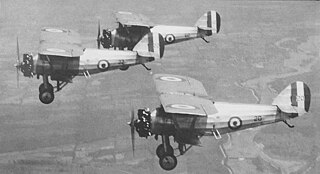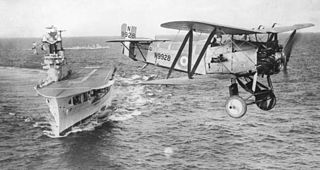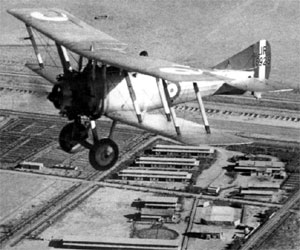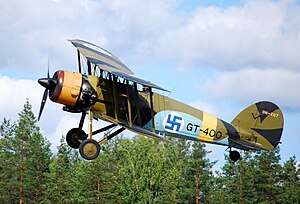
The Bristol Mercury is a British nine-cylinder, air-cooled, single-row, piston radial engine. Designed by Roy Fedden of the Bristol Aeroplane Company it was used to power both civil and military aircraft of the 1930s and 1940s. Developed from the earlier Jupiter engine, later variants could produce 800 horsepower (600 kW) from its capacity of 1,500 cubic inches by use of a geared supercharger.

The Gloster Gladiator is a British biplane fighter. It was used by the Royal Air Force (RAF) and the Fleet Air Arm (FAA) and was exported to a number of other air forces during the late 1930s.

The Hawker Hind was a British light bomber of the inter-war years produced by Hawker Aircraft for the Royal Air Force. It was developed from the Hawker Hart day bomber introduced in 1931.

The Bristol Bulldog is a British Royal Air Force single-seat biplane fighter designed during the 1920s by the Bristol Aeroplane Company. More than 400 Bulldogs were produced for the RAF and overseas customers, and it was one of the most famous aircraft used by the RAF during the inter-war period.

The Hawker Hart is a British two-seater biplane light bomber aircraft that saw service with the Royal Air Force (RAF). It was designed during the 1920s by Sydney Camm and manufactured by Hawker Aircraft. The Hart was a prominent British aircraft in the inter-war period, but was obsolete and already side-lined for newer monoplane aircraft designs by the start of the Second World War, playing only minor roles in the conflict before being retired.

The Armstrong Whitworth Siskin was a sesquiplane single-seat fighter aircraft developed and produced by the British aircraft manufacturer Armstrong Whitworth Aircraft. It was also the first all-metal fighter to be operated by the Royal Air Force (RAF), as well as being one of the first new fighters to enter service following the end of the First World War.

The Hawker Fury is a British biplane fighter aircraft used by the Royal Air Force in the 1930s. It was a fast, agile aircraft, and the first interceptor in RAF service capable of speed higher than 200 mph in level flight. It was the fighter counterpart to the Hawker Hart light bomber.

The Fairey Flycatcher was a British single-seat biplane carrier-borne fighter aircraft made by Fairey Aviation Company which served from 1923 to 1934. It was produced with a conventional undercarriage for carrier use, although this could be exchanged for floats for catapult use aboard capital ships.

The Gloster Grebe was developed by the Gloster Aircraft Company from the Gloster Grouse, and was the Royal Air Force's first post-First World War fighter aircraft, entering service in 1923.

The Vickers Vildebeest and the similar Vickers Vincent were two very large two- to three-seat single-engined British biplanes designed and built by Vickers and used as light bombers, torpedo bombers and in army cooperation roles. First flown in 1928, it remained in service at the start of the Second World War, with the last Vildebeests flying against Japanese forces over Singapore and Java in 1942.

The Hawker Henley was a British two-seat target tug derived from the Hawker Hurricane that was operated by the Royal Air Force during the Second World War.

The Hawker Woodcock was a British single-seat fighter built by the Hawker Engineering Company as the first fighter to be produced by Hawker Engineering. It was used by the RAF as a night fighter in the 1920s.

The Gloster Gamecock was a biplane fighter designed and produced by the British aircraft manufacturer Gloster.

The Westland Wapiti was a British two-seat general-purpose military single-engined biplane of the 1920s. It was designed and built by Westland Aircraft Works to replace the Airco DH.9A in Royal Air Force service.

The Gloster F.9/37, also known as the Gloster G.39, was a British twin-engined design from the Gloster Aircraft Company for a cannon-armed heavy fighter to serve with the Royal Air Force, planned before the Second World War. The F.9/37 was rejected in favour of other designs.

The Westland Wallace was a British two-seat, general-purpose biplane of the Royal Air Force, developed by Westland as a follow-on to their successful Wapiti. As the last of the interwar general purpose biplanes, it was used by a number of frontline and Auxiliary Air Force Squadrons. Although the pace of aeronautical development caused its rapid replacement in frontline service, its useful life was extended into the Second World War with many being converted into target tugs and wireless trainers. In 1933 a Westland Wallace became the first aircraft to fly over Everest, as part of the Houston-Mount Everest Flight Expedition.

The Gloster F.5/34 was a British fighter of the 1930s. It was a single-seat, single-engine monoplane of all-metal cantilever construction; the undercarriage was of the tailwheel type with retractable main wheels.

The Gloster SS.35 Gnatsnapper was a British naval biplane fighter design of the late 1920s. Two prototypes were built but the type did not enter production.

The Nightjar was a British carrier-based fighter aircraft of the early 1920s. It was a modification of the earlier Nieuport Nighthawk fighter produced by Gloster after the Nieuport & General company, which designed the Nighthawk, closed down. Twenty-two were converted, serving with the British Royal Air Force from 1922 to 1924.

The Nieuport Nighthawk was a British fighter aircraft developed by the Nieuport & General Aircraft company for the Royal Air Force towards the end of the First World War. Although ordered into production before the aircraft first flew, it did not enter large scale service with the RAF owing to unreliable engines. Re-engined aircraft did see service in Greece, serving from 1923 to 1938.


























